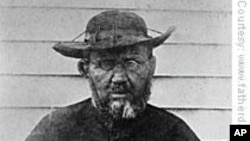<!-- IMAGE -->
Patients with Hansen's disease, also known as leprosy, were once banished from their homes because of fear of the infectious disease. Leprosy attacks the skin and nerves, sometimes causing disability and disfigurement. In the 1800's, there was no treatment for it. So patients in Hawaii were sent to the isolated peninsula of Kalaupapa on the island of Molokai. They were treated as outcasts until a Belgian priest, Father Damien, arrived to care for them. He eventually contracted the disease himself and died.
<!-- IMAGE -->
On October 11, he was canonized as a saint, and some of the last remaining Kalaupapa residents were in Rome for the ceremony.
The Kalauapapa peninsula is one of the most beautiful places on the planet. It's surrounded by the ocean, and the highest sea cliffs in the world. But during a tragic era of Hawaiian history, that landscape served as a natural prison. The only way to get there was by boat, or by hiking down a steep and treacherous trail. That's why patients with Hansen's disease were exiled to Kalaupapa in 1866.
Creating a caring community out of chaos
<!-- IMAGE -->
When Father Damien arrived in 1873, the settlement had descended into a state of semi-lawlessness. Damien was the first person to devote his life to caring for the patients. He protected the powerless from abuse, built a sense of community and helped the patients regain their dignity and hope. Today, more than a century after his death, Father Damien continues to inspire the Kalaupapa community and many others worldwide. Many say it is because of his compassion.
"To us, he's like a beacon," says Kalaupapa resident Norbert Palea. "He came in the worst years, and have lifted up our hearts, do not despair, have faith in God. He gave us faith and hope. Other people had exiled us and shunned us, but he gave us hope to live on and do not have hate. [Instead,] just be glad that you were born in that era, in his time."
Now 68, Palea is the youngest patient in Kalaupapa. He was just a little boy when he was sent there in the 1940s. Shortly afterwards, doctors found a cure for Hansen's disease.
Since Hawaii's forced isolation laws were abolished in 1969, most of the Kalaupapa residents, now cured, have chosen to stay in the community that has been their longtime home. But their numbers are dwindling. There are only about 20 patients remaining in the settlement, which is now a national historical park.
A community effort to send a delegation to Rome
<!-- IMAGE -->
Norbert Palea and 10 other patients were recently honored at a fundraiser to help send them to Rome to witness the canonization of Father Damien.
Clarence "Boogie" Kahilihiwa, the president of the patient advocacy group Ka `Ohana O`Kalaupapa says, "We are the living legacy right now of Kalaupapa." He is elated that he'll be watching Father Damien become a saint because, he says, the priest's spirit has touched so many lives.
"He was a man with affection. Not only affection, but he showed the world that he cared for people," Kahilihiwa says. And he points out that Father Damien was truly a member of the Kalaupapa community. "He was our brother because he had the same sickness. He had leprosy. I had leprosy."
The long road to sainthood
<!-- IMAGE -->
Since Father Damien's death, many have worked and prayed to have him officially declared a saint. He was beatified in 1995. Then, when a second woman was miraculously healed of her terminal illness after praying to Father Damien, the way was cleared for his canonization.
Father Damien becomes the first saint with ties to Hawaii. This means a lot to the patients who were once torn from their families and banished to Kalaupapa. Gloria Marks, who will also be attending the canonization, says it makes her very proud. "Because we're trying to carry on his work, what he was doing, educate the people, he was very helpful to the patients," Marks says.
Attending the canonization will be the trip of a lifetime for Marks and the other Kalaupapa patients. But the celebration is also bittersweet because they are representing the 8000 souls who were sent away to live and die in Kalaupapa.
He is why "we are still here"
<!-- IMAGE -->
Many others who also hoped to witness the ceremony, like Kuulei Bell, have passed away. Bell attended Father Damien's beatification in 1995. In an interview taped a few years later, she explained why he meant so much to the patients.
"Because it was through him that we still here. Because they said in 20 years, all of us would be dead. But no, we survived because of his effort, his fighting even the Catholic Church, and the government to try to get supplies and things in our behalf. And then becoming one of us. That's the bottom line," Bell said.
She also said, "He feels the emotion we feel. He can relate to us, that maybe nobody else can. Because he suffered. He had a reaction. He became disfigured. And he stayed. He dedicated his life. He literally dedicated his life."
Bell added, "I love him very much, even without knowing him. I think many of our patients feel the same way about this man. Otherwise, who'd come and take care of us?"
Father Damien is the tenth person whose work in what is now the United States led to sainthood.




